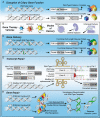Smelling the roses and seeing the light: gene therapy for ciliopathies
- PMID: 23601268
- PMCID: PMC3665744
- DOI: 10.1016/j.tibtech.2013.03.005
Smelling the roses and seeing the light: gene therapy for ciliopathies
Abstract
Alterations in cilia formation or function underlie a growing class of pleiotropic disorders termed ciliopathies. The genetic basis of ciliopathies is remarkably complex, with an incomplete but expanding list of more than 89 loci implicated in various disorders. Current treatment of ciliopathies is limited to symptomatic therapy. However, our growing understanding of ciliopathy genetics, coupled with recent advances in gene delivery and endogenous gene and transcript repair demonstrated thus far in tissues of the eye, nose, and airway, offers hope for curative measures in the near future. This review highlights these advances, as well as the challenges that remain with the development of personalized medicine for treating a very complex spectrum of disease, penetrant in a variety of organ systems.
Copyright © 2013 Elsevier Ltd. All rights reserved.
Figures


Similar articles
-
Olfactory Loss and Dysfunction in Ciliopathies: Molecular Mechanisms and Potential Therapies.Curr Med Chem. 2019;26(17):3103-3119. doi: 10.2174/0929867325666180105102447. Curr Med Chem. 2019. PMID: 29303074 Free PMC article. Review.
-
Primary ciliary dyskinesia: recent advances in epidemiology, diagnosis, management and relationship with the expanding spectrum of ciliopathy.Expert Rev Respir Med. 2012 Dec;6(6):663-82. doi: 10.1586/ers.12.60. Expert Rev Respir Med. 2012. PMID: 23234452 Review.
-
Chronic airway disease in primary ciliary dyskinesia-spiced with geno-phenotype associations.Am J Med Genet C Semin Med Genet. 2022 Mar;190(1):20-35. doi: 10.1002/ajmg.c.31967. Epub 2022 Mar 29. Am J Med Genet C Semin Med Genet. 2022. PMID: 35352480 Free PMC article. Review.
-
Therapeutic perspectives for structural and functional abnormalities of cilia.Cell Mol Life Sci. 2019 Oct;76(19):3695-3709. doi: 10.1007/s00018-019-03158-6. Epub 2019 May 30. Cell Mol Life Sci. 2019. PMID: 31147753 Free PMC article. Review.
-
Ciliopathies and the Kidney: A Review.Am J Kidney Dis. 2021 Mar;77(3):410-419. doi: 10.1053/j.ajkd.2020.08.012. Epub 2020 Oct 9. Am J Kidney Dis. 2021. PMID: 33039432 Review.
Cited by
-
Opportunities and Challenges for Molecular Understanding of Ciliopathies-The 100,000 Genomes Project.Front Genet. 2019 Mar 11;10:127. doi: 10.3389/fgene.2019.00127. eCollection 2019. Front Genet. 2019. PMID: 30915099 Free PMC article. Review.
-
Rpgrip1l controls ciliary gating by ensuring the proper amount of Cep290 at the vertebrate transition zone.Mol Biol Cell. 2021 Apr 15;32(8):675-689. doi: 10.1091/mbc.E20-03-0190. Epub 2021 Feb 24. Mol Biol Cell. 2021. PMID: 33625872 Free PMC article.
-
Managing Bardet-Biedl Syndrome-Now and in the Future.Front Pediatr. 2018 Feb 13;6:23. doi: 10.3389/fped.2018.00023. eCollection 2018. Front Pediatr. 2018. PMID: 29487844 Free PMC article. Review.
-
Gene Therapeutic Reversal of Peripheral Olfactory Impairment in Bardet-Biedl Syndrome.Mol Ther. 2017 Apr 5;25(4):904-916. doi: 10.1016/j.ymthe.2017.02.006. Epub 2017 Feb 22. Mol Ther. 2017. PMID: 28237838 Free PMC article.
-
Genotype-phenotype associations in a large PRPH2-related retinopathy cohort.Hum Mutat. 2020 Sep;41(9):1528-1539. doi: 10.1002/humu.24065. Epub 2020 Jul 5. Hum Mutat. 2020. PMID: 32531846 Free PMC article.
References
Publication types
MeSH terms
Grants and funding
LinkOut - more resources
Full Text Sources
Other Literature Sources
Medical

